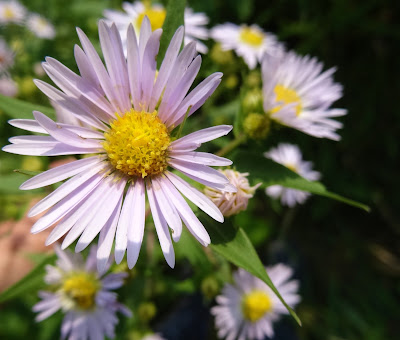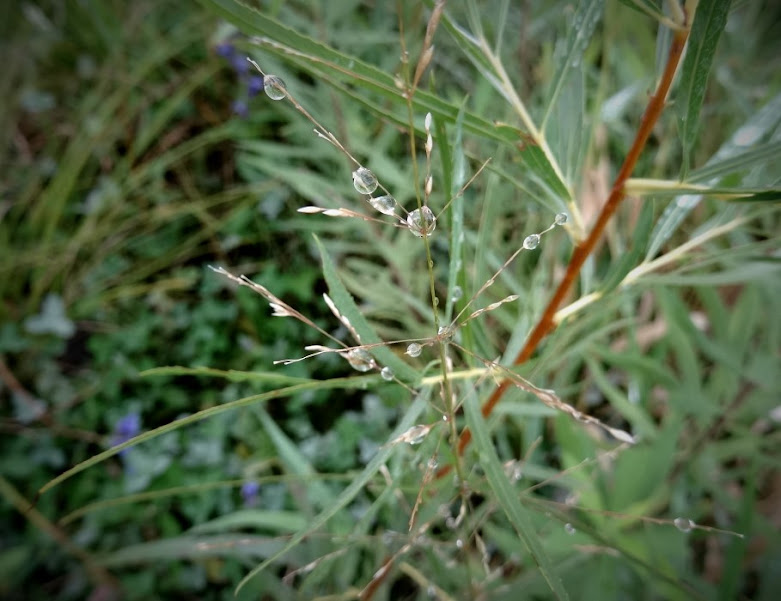Since we had several cold days and nights already, Painted Turtles Chrysemys picta who live in the pond are getting ready for winter. Lacking summer heat, this one was wandering very very slowly for a food item or a place to settle. Turtles will spend the next several months in frigid pond water below the frozen ice, with their metabolism and their heart rate slowed way down. They can absorb oxygen from the water through vascularized areas in their mouth, throat, and anus (cloacal respiration). But using oxygen produces lactic acid in their body, which the turtle counteracts with minerals released from its shell and bones. Painted Turtles do not eat during this time, but they do remain alert, especially to light from above. In Spring, when the hours of daylight increase, they will respond.
10/31/2020
10/28/2020
water sports
Sunny and warmer, closer to normal weather today, after an early snow in October. Several Mallards are getting ready for their travel south by feeding on the dwindling supply of plant material in the pond. But the resident muskrats do not like to share their food supply. We watched several encounters today between the animals.
10/24/2020
junco on snowy suet
Juncos arrived last week from nesting grounds north of here. Several made their way to our feeders. Usually, they stay in this area all winter, so it is important to locate some food sources before the snow flies. They will live on seeds from the native plants . . . and of course, suet.
10/20/2020
slush trail
Snow! Several inches. Before we were ready for it. Before the Mallards were ready for it. As they paddled around on the pond to find breakfast, they made a trail in the accumulating slush on the water.
10/19/2020
seed heads
I have been wandering the riparian buffer and clipping some of the wildflower seed heads to distribute them around the pond. Some native wildflowers exist here already, and we want to spread desirable plants throughout the buffer.
The clipping process is "a few for spreading to make new plants, most left for the birds."
Even after the seeds are gone, the structure of the plant is interesting!
10/18/2020
boneset in autumn
Boneset Eupatorium perfoliatum has a stout hairy stem, and the plant's leaves occur along it opposite to one another. In autumn, the flowers go to seed, and leaves turn a rich red-brown color.
The leaves are described as 'perfoliate' because each joins the opposite leaf around the stem so it appears the stem grows through one large leaf. All parts of this plant are toxic and bitter. Birds rarely eat the seeds, but are attracted to the flowers for the many insects there.
10/16/2020
10/08/2020
diving ducks
Mergansers stopped on the pond for a rest. They floated in the early sunlight for a while, then dived under water to search for a meal. Maybe they found aquatic insects, worms, frogs, or snails.
Below, the duck on the right is just gathering her body upward to curve down and dive. Because feathers make ducks buoyant, it takes muscles to dive. The one on the left is just emerging from a dive, as the water rolls off her head.
10/05/2020
floating pondweed
The floating leaves of Pondweed are fading at the end of summer. And the leaves of the nearby trees fall in the water, drift with the breeze, and catch on the Pondweed. They look golden in the sunlight, brighten the pond, and complement the wildflowers surrounding the water.
Floating Pondweed Potemogeton natans has two kinds of leaves; floating and submerged. The shiny leathery floating leaves are opaque, and support the whole plant which is rooted in the mud below. The submerged leaves are thin, transparent, and move with the water. In summer these plants provide habitats for many tiny aquatic invertebrates. These in turn are used as food by frogs, snakes, turtles, and ducks who feed here. After these plants die, their decomposition by bacteria and fungi provides food in turn for the aquatic invertebrates. The Pondweed survives winter with rhizomes buried in the mud at the bottom.
yellow loosestrife
9/28/2020
Phoebe in September

Phoebe is hunting at the pond today, balanced carefully on a reed bending over the water, with a reflection mirrored in the hazy sunlight.
Eastern Phoebes Sayornis phoebe are usually lone birds. Other than nesting season, one will rarely join another phoebe. They will sit upright and wag their tails from a low perch, looking for flying insects to eat.
They migrate south starting in September, wintering in the southern states. And, they are among the first migrants to return to their breeding grounds in spring, sometimes as early as March.

9/27/2020
muskrat tail
The muskrats who live here were gathering breakfast this morning in the pond. One, with tail held high, munched aquatic plants growing to just below the water surface. Their tails are 7 to 11 inches long, covered in scales rather than fur, and flattened vertically (side-to-side) to serve as a rudder in swimming.
9/26/2020
September wildflowers
9/25/2020
asters
9/24/2020
lavender asters
Asters in the Symphyotrichum genus may be blue, lavender, or white, and many shades of those colors. These lavender flowers, blooming now in the buffer around the pond, are one of approximately 25 aster plants native to Minnesota. Some of them provide food for bees and other insects through the late summer season.
9/22/2020
bur marigold
Even while fading and going to seed, the Bur Marigolds Bidens cernua nod as their seed load gets heavier. They are called 'Nodding Bur Marigold' for good reason. That makes them sound benign but their middle name 'bur' refers to the hard angled seeds with 4 barbed hooks that give them a free ride on passing animals or people to where they might sprout anew.
9/20/2020
leopard frog
Leopard Frogs Lithobates pipiens who live in our pond may travel one or two miles from water in the summer. You might hear them make a long, deep 'snore' noise lasting several seconds ending with a chuck-chuck-chuck. In the fall, Leopard Frogs come back to their pond. We saw this one hopping across the sandy shore. They spend the cold winter in the water, burrowed into the mud, hibernating with their metabolism slowed.
9/17/2020
lobelia still vibrant

9/15/2020
9/12/2020
9/10/2020
ducks in September
Mallards, dabbling ducks who rely on ponds like this one, have been growing and feeding in nearby crop fields while they molted into new feathers. Now we see them on the pond more often than in mid-summer. It is our signal to watch for daily duck visits as they prepare for migration.
9/09/2020
grasshopper on coneflower
On the blooming coneflowers, a Two-striped Grasshopper Melanoplus bivittatus rests in the sunshine. This grasshopper usually lives in sunny, moist, lush, weedy or meadow areas -- like the wetland around the pond. They eat a wide variety of plants, and sometimes also dead animal matter on the ground. They require unsaturated fatty acids in their diet since these nutrients help keep their wings strong and rigid.
9/08/2020
green heron scouting for prey
We have not seen the Green Heron Butorides virescens around the pond since mid-July. This one was balanced today on rocks near the shoreline, its thin legs crossed as it turned its body to spy prey below the water. After a while, it went into the grasses to hunt for another food item.
9/05/2020
Birds seek quiet hidden places while they molt into new feathers each year after nesting season. Here in Minnesota, most birds have passed that phase. So, again we are seeing dabbling ducks and diving ducks visit the pond. Early this morning, three Mergansers were floating on calm water warming themselves in the sunlight. After a while they began diving to find food. They eat fish, mollusks, aquatic insects, and plants. This one was poised to dive, with her wings up, feet back, and bill ready to lead her into the water.























